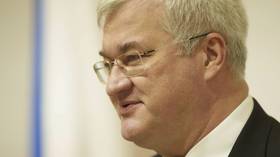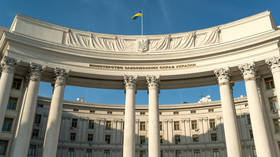Are Ukraine’s population figures totally inaccurate? Ex-PM claims 8mn emigrated since Maidan

Ukraine’s former PM claims more than eight million citizens have emigrated since the Western-backed Maidan in 2014. If he’s right, it adds to growing suspicions that Kiev’s population calculations are utterly out of whack.
Posting on Twitter, Nikolay Azarov noted: “More than 8 million Ukrainians left the country after the coup: 4.4 million went to Russia, 1.2 million to Poland, others went to other countries. Neither Libya, nor Syria, nor Afghanistan, nor other war-torn countries saw such a mass emigration.”
While the numbers at first seem extreme, they might not be totally outlandish. Polish officials admitted in spring of last year that more than one million Ukrainians were officially working in their country. And that was before Schengen visa-free access began, which may have swelled numbers engaged in the informal economy.
Meanwhile, sources suggested 2.6 million Ukrainians were registered in Russia by 2016. An accurate headcount is difficult to ascertain due to the lack of visa restrictions at the border. Also, Franz Klintsevich, first deputy head of the Russian Federation Council committee on defense and security, has publicly mentioned a figure of four million Ukrainians formally employed in Russia.
According to Azarov’s information, Ukraine’s real population is considerably below the 42 million claimed by Kiev authorities last year, a figure little changed since 2014. It the data is that unreliable, it would be unprecedented in modern-day Europe.
Reasons to believe
The comments also feed into a wider debate about Ukraine’s questionable national statistics. The troubled state hasn’t conducted a national headcount since 2001. Furthermore, the official average wage levels appear to be too low to be true (currently €220 monthly), in a country where at least the major cities seem to be relatively prosperous.
Back in 2001, the results showed Ukraine had 48.4 million residents, down from a figure of 52 million when the USSR collapsed in 1991.
Anatoly Karlin, a Russian writer at America’s Unz Review who focusses on demographics, claims there are only three explanations for the apparent contradiction. “Either Ukraine is experiencing a baby-boom far bigger than anywhere else in eastern Europe, which seems unlikely given [the current] economic circumstances [or] Ukraine is also fiddling its fertility statistics [or] this theory is nonsense, [and is a] mirror image of ‘dying Russian bear’ trope.”
In his last point, Karlin is referring to the western media obsession with depicting Russia as a country facing demographic disaster, despite the fact the population has stabilized at around 143 million since 2005 (excluding Crimea) and actually saw a small increase between 2009-2016. Indeed, Russia’s core numbers are only down 2.7 percent since 1991, in contrast to incredible falls in other former communist states such as Romania (16.6 percent), Latvia (27.2 percent), Lithuania (22.4 percent) and Armenia (16.3 percent). So, while Russia faces considerable challenges in this regard, it seems to have managed the post-Soviet transition better than most of its western neighborhood, despite the disastrous nineties.
Last year, Andrey Fomin, of the Moscow-based “Oriental Review,” conducted an investigation into Ukraine’s murky statistics, which he compared to Nikolay Gogol’s legendary novel “Dead Souls.” He estimated that the country’s current population is at most 33.5 million (or 35.7 million, including Crimea). This would be almost seven million less, even with the errant province thrown in, than the authorities claim.
Fomin found that Kiev doesn’t “clock out” citizens who emigrate and only registers internal migration. He also pointed out that bread consumption (the dietary staple of Ukrainians) had fallen by 55 percent between 2000 and 2016, which indicates the number of consumers had fallen off a cliff. Unless, of course, the populace has suddenly switched to Atkins-style diets, which seems unlikely.
Smoke screen
The analyst further backed up his argument by pointing out “during the 1995/1996 school year there were 7.1 million schoolchildren in Ukraine. But, it was down to 3,783,150 (official data of the Ministry of Education of Ukraine) by the 2015/2016 school year, or 47 percent in 20 years.”
Potential reasons for the lack of urgency in conducting a proper survey are numerous. They could include tricking the IMF and the EU by making it look as though Ukraine is more stable than it actually is; helping some officials to become richer, through syphoning off unused energy from vacant homes (most Ukrainian housing complexes use centralized heating systems); enabling election fraud or minimizing the publicly known casualties of the civil war.
Whatever the true population of Ukraine, the fact that no census has been held for 17 years is beyond bizarre. It’s also notable that the country’s western sponsors haven’t insisted on one being held immediately.
Meanwhile, scholars and journalists continue to focus on Russia’s demographics, with some justification, while ignoring the far greater malaise in its estranged neighbour. Highly selective reporting at its best.
The statements, views and opinions expressed in this column are solely those of the author and do not necessarily represent those of RT.














